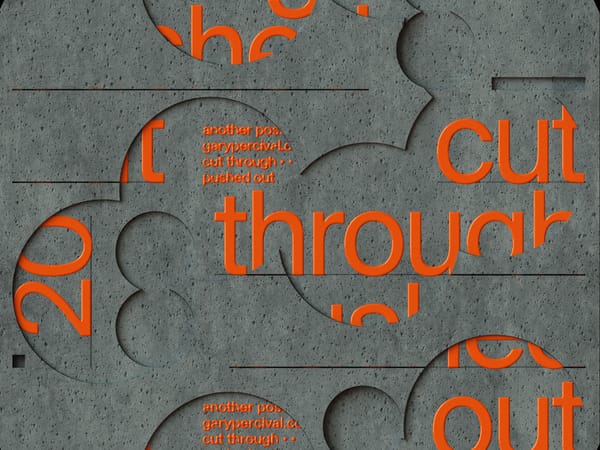Before You Chase It, Ask If It’s Worth Catching
“You’re not just chasing a moment. You’re choosing a direction.”

We’ve all been there.
A shiny opportunity appears—a client, a job, a project, a trend—and you feel that familiar tug: I need to go after this.
Your brain lights up: What if this is the big one? The thing that changes everything? The one you’ll regret not chasing?
But here’s a powerful question to sit with before you run:
Is it actually worth catching?
Because not everything that sparkles is gold.
Not every opportunity leads somewhere meaningful.
And not every chase is worth the energy it costs.
The Cost of the Chase
Chasing is active. It’s exciting. It feels like progress.
But it’s also demanding. Time-consuming. Draining.
Every chase comes at a cost:
- Time you could spend creating something of your own
- Energy that could go toward a project you already care about
- Focus that could be used to deepen your craft instead of proving it
And the hard truth? Some things just aren’t worth the sprint.
That client who promises “exposure”?
The project that looks impressive on paper but doesn’t pay or align?
The social trend everyone’s hopping on, even though it doesn’t match your style?
These are the distractions dressed as opportunities.
Why We Chase
Understanding the why behind our chasing can help us slow down and reframe.
FOMO (Fear of Missing Out)
In a scroll-happy world, it’s easy to feel behind. Someone’s always announcing a big win. A new partnership. A successful launch.
And so we chase just to keep up—forgetting that we may be running toward something that wasn’t meant for us in the first place.
Validation-Seeking
Sometimes we chase because we want to be seen. Approved. Chosen.
But when the goal is external recognition, we can lose sight of our own values.
We end up creating work for applause, not impact.
Default Mode
Some of us just default to movement. If we’re not chasing something, we feel stuck.
Even when there’s no clear payoff, we keep refreshing our inbox, scanning job boards, or jumping on trends—just to feel in motion.
But action without direction isn’t progress—it’s noise.
And noise, over time, drowns out your own voice.
The Smarter Question: “What’s at the Finish Line?”
Instead of asking, “How do I get it?”, try asking:
“What happens if I get it?”
- What will this project lead to?
- What kind of people will I meet through it?
- Will I be proud to have done it six months from now?
- Is it building the career I actually want—or distracting me from it?
If you can’t picture the destination—or if the destination doesn’t excite you—pause.
The chase may not be worth it.
The Creative Trap of Misaligned Goals
This is especially tricky for creatives.
Sometimes, a project looks objectively good. It’s high-profile. It pays well. It’ll look flashy on your website.
But if it doesn’t align with your creative vision or values, it may pull you off course.
Over time, a series of misaligned chases can lead you somewhere you never meant to go.
Your work looks polished. But it doesn’t feel like yours.
Your portfolio is full. But not fulfilling.
Your name is on the work—but your heart isn’t.
What Makes Something Worth Catching?
Let’s flip the question. Instead of asking what to avoid, let’s ask: What’s worth pursuing?
Here are some signs a goal is worth your energy:
It aligns with your long-term vision
You can clearly see how it fits into the kind of work—and life—you want.
It energises you
It’s the kind of project you’d still think about even if no one else saw it.
It challenges your creativity
It asks you to stretch, not shrink. To grow, not conform.
It has integrity
The people are respectful. The values are clear. The process doesn’t compromise your ethics or standards.
It builds toward something
It might not be perfect, but it’s a step toward something meaningful—new skills, better clients, deeper impact.
Micro-Chases vs. Macro-Chases
Not every chase is a life-defining one.
Some are small sprints—an experiment, a short-term risk, a creative detour.
That’s fine—if you know what it is.
The danger is when we confuse a micro-chase for a macro-goal.
Example?
- Spending weeks creating content for a trend that dies in a month
- Accepting a project just because a competitor wanted it
- Pouring time into pitching a job that doesn’t even match your ambitions
There’s nothing wrong with short-term sprints.
Just make sure they’re in service of a long-term direction.
Permission to Stop Chasing
You don’t have to chase every opportunity.
You do not need to establish your worth by being busy.
You don’t have to be in motion just because everyone else is.
Sometimes, the bravest thing you can do is stand still and choose.
To wait for the right fit.
To make your own opportunity.
To go deeper instead of wider.
Standing still doesn’t mean stagnation. It means intention.
When It Is Time to Chase
There are moments to go all in. When something resonates deeply and aligns clearly—run toward it.
But chase it because it matters. Not because it’s there.
- Chase the project that excites your future self.
- Chase the skill that unlocks new creative freedom.
- Chase the collaboration that multiplies your impact.
- Chase the version of your career you’d want even if no one was watching.
In other words: Chase what’s yours—not what belongs to someone else’s path.
How to Audit the Chase
Before you say yes, pause long enough to ask:
- What exactly am I chasing—and why?
Is it for growth? Connection? Ego? Approval? Be honest. - Does it move me closer to the kind of work I want to be known for?
Or does it just fill the time (and drain the energy)? - What am I giving up to make room for this?
Every yes comes at the cost of another focus. - Will I still stand by this decision when the buzz wears off?
Hype fades. Alignment sticks. - Is this forward motion—or just motion?
There’s a difference between chasing and progressing.
Write your answers down. Not just once, but often.
Patterns emerge. Priorities clarify. And soon, you’re not just chasing—you’re choosing.
Final Thoughts: Aim With Intention, Not Impulse
You are not a machine. You’re a creative—an architect of ideas and meaning.
Your energy is limited. Your time is precious.
So don’t spend your days chasing things just because they’re visible, trending, or popular.
Ask yourself:
Is this helping me build the creative life I actually want?
Or am I just busy chasing something I never truly needed?
You’re not just chasing a moment. You’re choosing a direction.
Every opportunity asks something of you.
The ones worth catching help you build a creative life on your terms.
That single shift—from chasing out of impulse to choosing with intention—can change not just your work, but how you feel doing it.



